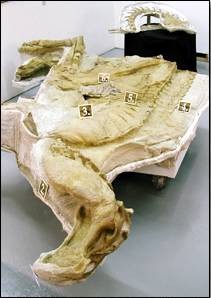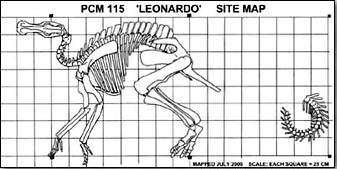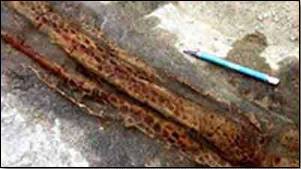|
Dino-Mummy Shows Some Skin A mummified dinosaur, unwrapped from the rocks of Montana, has revealed how the creature looked and how it lived 77 million years ago right down to the texture of its skin and the contents of its stomach. The Duckbill Dinosaur, nicknamed Leonardo, was fossilized in an unusual way, its discoverers reported at the Society of Vertebrate Paleontology’s meeting in Norman, Oklahoma. Only a handful of such dinosaur mummies are known to exist, they said. Mummified fossils are by no means like the linen-wrapped Egyptian remains from mere thousands of years ago. Rather, the specimens have turned to minerals in such a way that they preserve the look of the skin and internal tissue. In the past, scientists have theorized that mummified dinosaur flesh was dried out before it became a fossil. However, researchers at the Judith River Dinosaur Institute and Phillips County Museum in Malta, Montana, believe Leonardo took a different path to posterity. “We think that it was buried in wet river sand around 77 million years ago, and much of the flesh was intact when fossilization started,” said Dave Trexler, paleontologist with Timescale Adventures and a co-author of Leonardo’s technical description.
"The pollen from its stomach also shows that the environment was to wet for much desiccation to take place before burial." The other co-authors are Nate Murphy, a curator of paleontology at the |
|||
| Phillips County Museum and geologist Mark Thompson, a member of the discovery team who worked on preparing the specimen. "A very rare sequence of events was necessary for this type of preservation to occur," Thompson said in a news release on the discovery. "It's a once-in-a-lifetime find." The two-ton, 23-foot-long (7-meter-long) fossil went on display this summer after thousands of hours of preparatory work. Paleontologists say Leonardo was a brachylophosaurus — a type of duckbill dinosaur, or hadrosaur — who died when it was about 3 years old. The fossil features a three-dimensional rock cast of the right shoulder muscle and throat tissue, along with traces of the skin, toenails, beak and internal organs. Within the fossilized stomach, researchers reportedly could make out shapes from Leonardo’s last lunch: ferns, conifers and a magnolia-type plant. |
|
|||
|
The researchers said such details
could shed new light on how such dinosaurs were built and how they moved.
For example, the plant-eating species might have used its forelimbs more
than previously thought, based on an analysis of the fossilized muscles.
Even the stomach contents could provide insights into the flora of the Late
Cretaceous period. Yet another mummified dinosaur fossil — this one from a meat-eating tyrannosaur — was reportedly unearthed last year in Wyoming’s Lance Creek Fossil Area. |
|||
 The
duckbill fossil, named Leonardo, is laid out for display at the Phillips
County Museum in Montana. The numbers are keyed to information about
areas of the 23-foot-long fossil. A separate portion of the tail
can be seen in the background of the photo.
The
duckbill fossil, named Leonardo, is laid out for display at the Phillips
County Museum in Montana. The numbers are keyed to information about
areas of the 23-foot-long fossil. A separate portion of the tail
can be seen in the background of the photo. This
site map of Leonardo at excavation shows where erosion
removed a section of the tail, the only part missing from the otherwise
complete animal.
This
site map of Leonardo at excavation shows where erosion
removed a section of the tail, the only part missing from the otherwise
complete animal. In a photo
taken from video footage of the excavation, the left forelimb of
Leonardo shows the polygonal, scaly appearance of the skin. A pencil is
included in the picture for size comparison.
In a photo
taken from video footage of the excavation, the left forelimb of
Leonardo shows the polygonal, scaly appearance of the skin. A pencil is
included in the picture for size comparison.